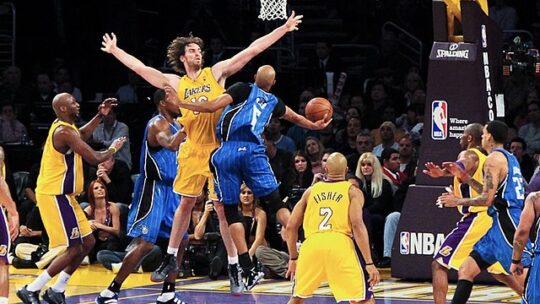Basketball Concepts and Techniques, Selecting an Offense
Winning offenses are many and varied, as there are winning coaches. To be successful, any offense must create high-percentage scoring situations from the basic offensive set and secondary options while maintaining adequate rebound coverage and defensive balance.
Those involved in the primary aspect must attack the defense to immobilize it. Meanwhile, the other players must use decoying tactics to divert their opponent’s attention away from the focal point of attack.
At the same time, they must be prepared to carry out their other team functions of rebounding, defensive balance, secondary shooting, etc.
Many different approaches to an offense may be used. Each should be carefully thought out and skillfully taught based on the talents of available players who have been or are being, instructed in the individual fundamentals.
Selecting An Offense
The coach chooses the offense to be used by his team, basing his decision on his philosophy and his player’s abilities. He should adapt the good parts of any system to his philosophy, striving for maximum efficiency within the framework of the total skills of the players involved.
Seldom do all players on a starting team possess similar abilities; therefore, the coach should use the positive attributes of each in his offensive planning. He must blend his players’ talents as a team.
At the same time, he must take measures to protect players who lack talent in certain areas. He should assign duties that best utilize the personal abilities of each player.
Good ball handlers should handle the ball most of the time, and good cutters should be exploited. The best rebounders should be able to rebound, and knowledgeable teammates should constantly screen for good shooters.
His essential shooting ability should determine the types of shots each player takes. Perfection of the offense comes from constant practice of correct techniques. This is accomplished in small groups of two or three, then in team groups using drills incorporating various aspects of the team offense. Speed, timing, and deception of movement are essential factors in the offense’s effectiveness.
A coach should constantly be learning. He should read books and magazines on basketball. He should attend clinics and swap ideas with other coaches, integrating any new tactics suitable for his personnel into his offense. Offenses are only sometimes familiar. One used ten years from now will be an adaptation of something that was in everyday use five years ago.
The coach should know his material before installing a system. If he is new and doesn’t know his material, his pre-season practice will be essential in determining the method.
The success of any system is due more to the person than the coach. If it is the wrong system, regardless of the coach’s ability, it cannot succeed. For example, a coach with slow players cannot fast break effectively. He cannot use a four or five-man weave efficiently if he has tall, uncoordinated players.
As a rule, coaches should not change their offense in mid-stream. When change is essential, they should adapt from the existing structure so that the change will be moderate. All offenses should be adaptable for use against the three types of defense: man-to-man, zone, and combination.
Personnel
While coaches should try to have the best combination of personnel as quickly as possible, they should not be too hasty in their selection. It is best to keep players on their toes and unsure of their position for a while to obtain maximum potential from each man.
The best teams have set starting combinations; therefore, coaches should practice their five best players together as a unit as soon as their superior ability is evident. The more compatible the players are off the court, the better they will function on the court. Through bull sessions, they will obtain a better understanding of their characteristics.
Necessary changes must be made decisively. The team should know before the coach that changes should be made. Coaches typically need two or three replacements at most. He will require changes in the center position, the forward position, and the guard position.
If only two reserves exist, the difference might be to a forward-center combination or a guard-forward combination. Starters may be moved to new positions, but it is not advisable.
Replacements must have as much practice time and game time as possible. This allows them to coordinate their movements with those of the starters. Coaches should never wait until pressure situations to insert a first-line sub.
Type of Offense
There are two types of offense: free-lance and controlled. In a free-lance offense, players make their offense, depending on the defensive deployment and opponents’ ability. Free-lance is more accessible and uncontrolled than the term implies because all two-on-two and three-on-three plays should be drilled thoroughly.
Control basketball is a system in which a team maintains control of the ball until one player is in an unguarded high-percentage area. Any basic system can be used to implement a control type of basketball.
There are several basic offensive systems that teams may use in their attempt to obtain high-percentage shots. All must fall into one of the following classifications based on the position of the offensive players concerning the basket and the defensive players guarding them.
- Five Offensive Players Outside.
If five offensive players are eighteen to twenty feet from the basket, all defensive players are closer to the basket than the nearest offensive player. Offenses that begin from this structure are a three-two-wide and a five-man weave.
- Four Offensive Players Outside and One Inside.
Four offensive players are farther out than their four opponents, and one player is nearer the basket. Usually, this is a four-man weave system or a single pivot type of offense in which the corner men are approximately eighteen or nineteen feet from the basket.
- Three Offensive Players Outside and Two Inside.
Three offenses start from this structure.
- A double pivot places the two more prominent men closer to the basket than the other three. A three-two offense may have three frontmen moving while the two inside men work a buddy system closer to the basket.
- A one-three-one offense uses a tandem pivot, one high and one low.
- An overload offense overloads one side of the court, passing the ball to the side with only one player and having a teammate away from the ball cut off a postman toward the ball.
- Two Offensive Players Outside and Three Inside.
This is a standard two-three offense in which the forwards are within eighteen feet of the basket.
- One Offensive Player Outside and Four Inside.
This is a very effective primary offense considering the type of defenses used today. Designated the stack offense, it has four players close to the basket.



